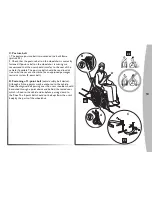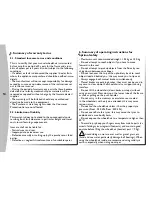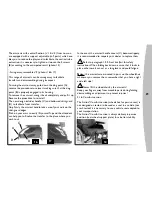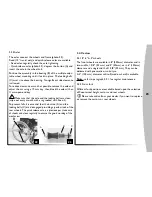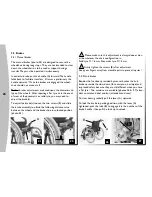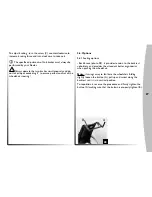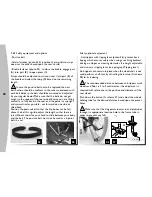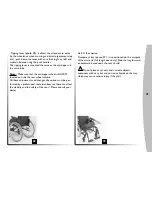
26
27
2.5. Brakes
2.5.1 Manual brakes
The manual brakes (photo 24) are designed to secure the
wheelchair during long stops. They are not intended to slow
down the wheelchair or to be used as support during a
transfer. They must be operated simultaneously.
In order to brake, push the handle (A) forward. The handle
folds back to facilitate transfers. Draw as a preliminary the
handle upwards ! Once the brakes are engaged, the wheel-
chair should not move at all.
Note :
brakes adjustments are based upon the diameter and
type of the wheels. After repairing a flat tyre or in the event
of wear of the pneumatic or solid tyre, you may need to
adjust the brake(s).
To adjust the brake(s), loosen the two screws (B) and slide
the brake assembly to obtain the following distance value
between the wheel and the brake shoe in unlocked position.
(photo 25)
!
Please make sure this adjustment is always done as des-
cribe whatever the chair configuration is.
Solid tyre X = 6 mm, Pneumatic tyre X = 5 mm
!
Firmly tighten the screws (B) after adjustment.
Keep your fingers away from movable parts to prevent injuries !
2.5.2 Hub brakes
Besides the functions provided by manual brakes, the hub
brakes provide the slow down (for example, on a slope) and
improved safety because they are still efficient when you have
a flat tyre ! Two versions are available: (photos 26 & 27) atten-
dant control and dual control (attendant and user).
To slow down, gradually pull the lever (A) upwards.
To lock the brake in parking position, with the lever (A)
tightened, push the lock (B) to engage it in the notches of the
brake handle ; then pull the lock up to unlock.
24
A
B
X
25
27
C
26
A
B


